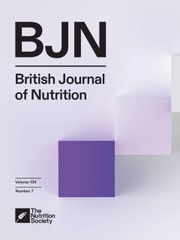Crossref Citations
This article has been cited by the following publications. This list is generated based on data provided by
Crossref.
Westerterp-Plantenga, Margriet S.
and
Lejeune, Manuela P.G.M.
2005.
Protein intake and body-weight regulation.
Appetite,
Vol. 45,
Issue. 2,
p.
187.
Westerterp-Plantenga, M S
Luscombe-Marsh, N
Lejeune, M P G M
Diepvens, K
Nieuwenhuizen, A
Engelen, M P K J
Deutz, N E P
Azzout-Marniche, D
Tome, D
and
Westerterp, K R
2006.
Dietary protein, metabolism, and body-weight regulation: dose–response effects.
International Journal of Obesity,
Vol. 30,
Issue. S3,
p.
S16.
Halkjær, Jytte
Tjønneland, Anne
Thomsen, Birthe L
Overvad, Kim
and
Sørensen, Thorkild IA
2006.
Intake of macronutrients as predictors of 5-y changes in waist circumference.
The American Journal of Clinical Nutrition,
Vol. 84,
Issue. 4,
p.
789.
Moran, Lisa J
Noakes, Manny
Clifton, Peter M
Wittert, Gary A
Williams, Gemma
and
Norman, Robert J
2006.
Short-term meal replacements followed by dietary macronutrient restriction enhance weight loss in polycystic ovary syndrome.
The American Journal of Clinical Nutrition,
Vol. 84,
Issue. 1,
p.
77.
Westerterp-Plantenga, M.S.
2006.
Improving the Fat Content of Foods.
p.
162.
Blaak, E E
2006.
Prevention and treatment of obesity and related complications: a role for protein?.
International Journal of Obesity,
Vol. 30,
Issue. S3,
p.
S24.
Lejeune, Manuela PGM
Westerterp, Klaas R
Adam, Tanja CM
Luscombe-Marsh, Natalie D
and
Westerterp-Plantenga, Margriet S
2006.
Ghrelin and glucagon-like peptide 1 concentrations, 24-h satiety, and energy and substrate metabolism during a high-protein diet and measured in a respiration chamber.
The American Journal of Clinical Nutrition,
Vol. 83,
Issue. 1,
p.
89.
Luhovyy, Bohdan L.
Akhavan, Tina
and
Anderson, G. Harvey
2007.
Whey Proteins in the Regulation of Food Intake and Satiety.
Journal of the American College of Nutrition,
Vol. 26,
Issue. 6,
p.
704S.
Apolzan, John W.
Carnell, Nadine S.
Mattes, Richard D.
and
Campbell, Wayne W.
2007.
Inadequate Dietary Protein Increases Hunger and Desire to Eat in Younger and Older Men.
The Journal of Nutrition,
Vol. 137,
Issue. 6,
p.
1478.
Manninen, Anssi H.
2007.
Are High-Protein Diets Safe for Kidney Function?.
Journal of the American Dietetic Association,
Vol. 107,
Issue. 10,
p.
1722.
2007.
Amino Acids and Proteins for the Athlete.
Vol. 20071276,
Issue. ,
p.
207.
Skidmore, P.
2007.
Macronutrient intakes and their role in obesity.
Nutrition Bulletin,
Vol. 32,
Issue. s1,
p.
4.
Kasim-Karakas, Sidika E
Cunningham, Wendy M
and
Tsodikov, Alex
2007.
Relation of nutrients and hormones in polycystic ovary syndrome.
The American Journal of Clinical Nutrition,
Vol. 85,
Issue. 3,
p.
688.
Keogh, Jennifer B.
Luscombe-Marsh, Natalie D.
Noakes, Manny
Wittert, Gary A.
and
Clifton, Peter M.
2007.
Long-term weight maintenance and cardiovascular risk factors are not different following weight loss on carbohydrate-restricted diets high in either monounsaturated fat or protein in obese hyperinsulinaemic men and women.
British Journal of Nutrition,
Vol. 97,
Issue. 2,
p.
405.
Westerterp-Plantenga, Margriet S.
2007.
How are normal, high- or low-protein diets defined?.
British Journal of Nutrition,
Vol. 97,
Issue. 2,
p.
217.
Leidy, Heather J.
Carnell, Nadine S.
Mattes, Richard D.
and
Campbell, Wayne W.
2007.
Higher Protein Intake Preserves Lean Mass and Satiety with Weight Loss in Pre‐obese and Obese Women.
Obesity,
Vol. 15,
Issue. 2,
p.
421.
Westerterp‐Plantenga, M. S.
Smeets, A.
and
Nieuwenhuizen, A.
2007.
Sustained protein intake for bodyweight management.
Nutrition Bulletin,
Vol. 32,
Issue. s1,
p.
22.
Diepvens, K
Soenen, S
Steijns, J
Arnold, M
and
Westerterp-Plantenga, M
2007.
Long-term effects of consumption of a novel fat emulsion in relation to body-weight management.
International Journal of Obesity,
Vol. 31,
Issue. 6,
p.
942.
Veldhorst, Margriet A. B.
Nieuwenhuizen, Arie G.
Hochstenbach-Waelen, Ananda
Westerterp, Klaas R.
Engelen, Marielle P. K. J.
Brummer, Robert-Jan M.
Deutz, Nicolaas E. P.
and
Westerterp-Plantenga, Margriet S.
2008.
Comparison of the effects of a high- and normal-casein breakfast on satiety, ‘satiety’ hormones, plasma amino acids and subsequent energy intake.
British Journal of Nutrition,
Vol. 101,
Issue. 2,
p.
295.
Paddon-Jones, Douglas
Westman, Eric
Mattes, Richard D
Wolfe, Robert R
Astrup, Arne
and
Westerterp-Plantenga, Margriet
2008.
Protein, weight management, and satiety.
The American Journal of Clinical Nutrition,
Vol. 87,
Issue. 5,
p.
1558S.




